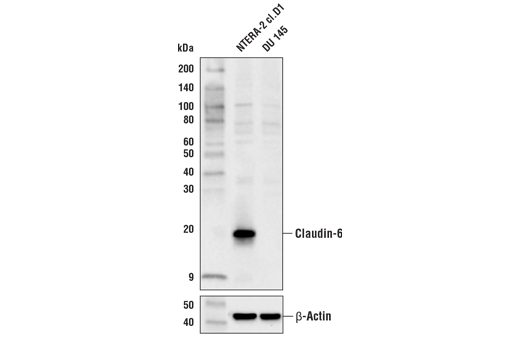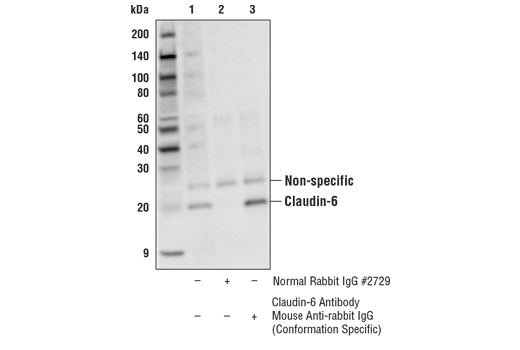WB, IP
H
Endogenous
23
Rabbit
#P56747
9074
Product Information
Product Usage Information
| Application | Dilution |
|---|---|
| Western Blotting | 1:1000 |
| Immunoprecipitation | 1:50 |
Storage
Specificity / Sensitivity
Species Reactivity:
Human
Source / Purification
Polyclonal antibodies are produced by immunizing animals with a synthetic peptide corresponding to residues near the carboxy terminus of human Claudin-6 protein. Antibodies are purified by protein A and peptide affinity chromatography.
Background
Tight junctions, or zonula occludens, form a continuous barrier to fluids across the epithelium and endothelium. They function in regulation of paracellular permeability and in the maintenance of cell polarity, blocking the movement of transmembrane proteins between the apical and the basolateral cell surfaces. Tight junctions are composed of claudin and occludin proteins, which join the junctions to the cytoskeleton (1,2). The claudin family is composed of 23 integral membrane proteins, and their expression, which varies among tissue types, may determine both the strength and properties of the epithelial barrier. Alteration in claudin protein expression pattern is associated with several types of cancer (2,3). Claudin-1 is expressed primarily in keratinocytes (4) and normal mammary epithelial cells, but is absent or reduced in breast carcinomas and breast cancer cell lines (5,6).
Claudin-6 is a member of the CLDN family that is expressed in epithelial cell sheets. Downregulation of Claudin-6 has been reported in breast invasive ductal carcinoma associated with lymphatic metastasis which may point to a function of Claudin-6 as a tumor suppressor. Claudin-6 is reported to play a role in inhibiting malignancy of breast cancer cells by inducing apoptosis, inhibiting proliferation and migration. Mechanisms of action of Claudin-6 have been described through various signaling pathways such as p38-MAPK, JAKs-STATs, ASK1-JNK, and other pathways (7,8). Regulation of Claudin-6 expression may occur through epigenetic mechanisms (9).
Other reports describe aberrant expression in various malignancies (10,11). The clinical significance of Claudin-6 dysregulation has created interest in the potential for pharmaceutical intervention (12-14).
- Shin, K. et al. (2006) Annu Rev Cell Dev Biol 22, 207-35.
- Oliveira, S.S. and Morgado-Díaz, J.A. (2007) Cell Mol Life Sci 64, 17-28.
- Hewitt, K.J. et al. (2006) BMC Cancer 6, 186.
- Brandner, J.M. et al. (2002) Eur J Cell Biol 81, 253-63.
- Krämer, F. et al. (2000) Hum Genet 107, 249-56.
- Swisshelm, K. et al. (1999) Gene 226, 285-95.
- Wu, Q. et al. (2013) Chin Med J (Engl) 126, 3539-44.
- Guo, Y. et al. (2016) Int J Oncol 48, 2435-44.
- Liu, Y. et al. (2016) J Exp Clin Cancer Res 35, 120.
- Zhang, X. et al. (2015) Med Oncol 32, 148.
- Torres-Martínez, A.C. et al. (2017) Exp Cell Res 350, 226-35.
- Micke, P. et al. (2014) Int J Cancer 135, 2206-14.
- Ben-David, U. et al. (2013) Nat Commun 4, 1992.
- Schneider, I.C. et al. (2018) Biotechnol J 13, e1700345.
Species Reactivity
Species reactivity is determined by testing in at least one approved application (e.g., western blot).
Western Blot Buffer
IMPORTANT: For western blots, incubate membrane with diluted primary antibody in 5% w/v nonfat dry milk, 1X TBS, 0.1% Tween® 20 at 4°C with gentle shaking, overnight.
Applications Key
WB: Western Blotting IP: Immunoprecipitation
Cross-Reactivity Key
H: human M: mouse R: rat Hm: hamster Mk: monkey Vir: virus Mi: mink C: chicken Dm: D. melanogaster X: Xenopus Z: zebrafish B: bovine Dg: dog Pg: pig Sc: S. cerevisiae Ce: C. elegans Hr: horse GP: Guinea Pig Rab: rabbit All: all species expected
Trademarks and Patents
Limited Uses
Except as otherwise expressly agreed in a writing signed by a legally authorized representative of CST, the following terms apply to Products provided by CST, its affiliates or its distributors. Any Customer's terms and conditions that are in addition to, or different from, those contained herein, unless separately accepted in writing by a legally authorized representative of CST, are rejected and are of no force or effect.
Products are labeled with For Research Use Only or a similar labeling statement and have not been approved, cleared, or licensed by the FDA or other regulatory foreign or domestic entity, for any purpose. Customer shall not use any Product for any diagnostic or therapeutic purpose, or otherwise in any manner that conflicts with its labeling statement. Products sold or licensed by CST are provided for Customer as the end-user and solely for research and development uses. Any use of Product for diagnostic, prophylactic or therapeutic purposes, or any purchase of Product for resale (alone or as a component) or other commercial purpose, requires a separate license from CST. Customer shall (a) not sell, license, loan, donate or otherwise transfer or make available any Product to any third party, whether alone or in combination with other materials, or use the Products to manufacture any commercial products, (b) not copy, modify, reverse engineer, decompile, disassemble or otherwise attempt to discover the underlying structure or technology of the Products, or use the Products for the purpose of developing any products or services that would compete with CST products or services, (c) not alter or remove from the Products any trademarks, trade names, logos, patent or copyright notices or markings, (d) use the Products solely in accordance with CST Product Terms of Sale and any applicable documentation, and (e) comply with any license, terms of service or similar agreement with respect to any third party products or services used by Customer in connection with the Products.

